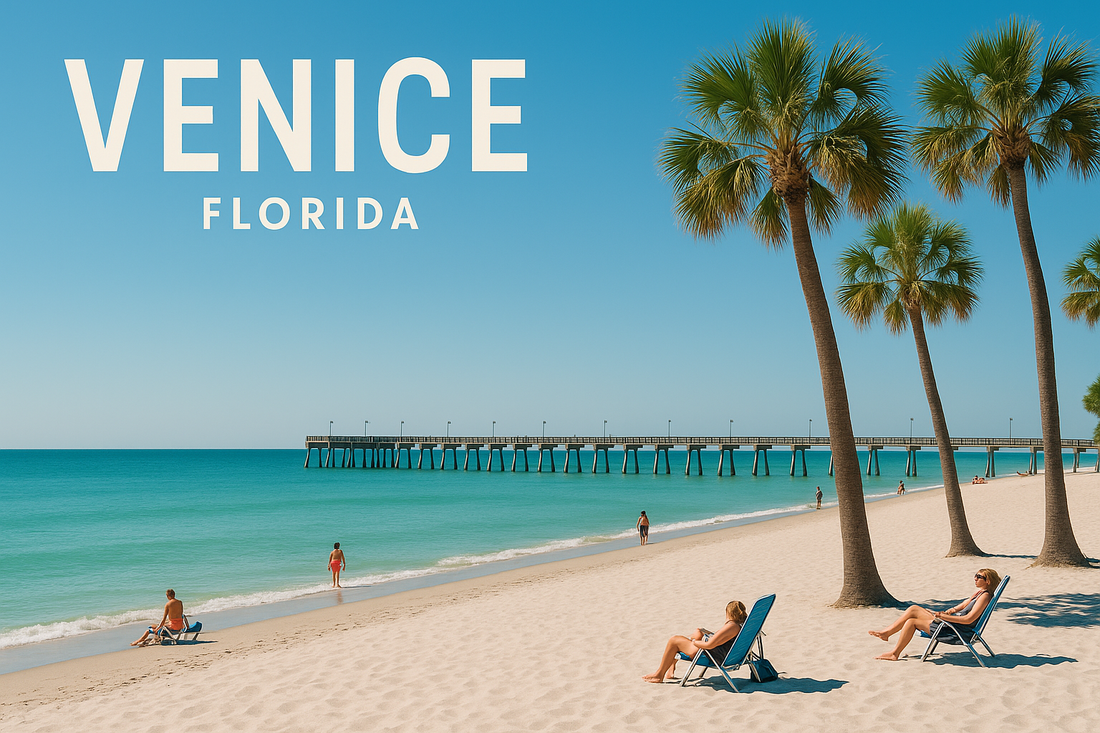
Why Venice, Florida Has So Many Shark Teeth
Venice, Florida has earned the nickname “Shark Tooth Capital of the World” — and for good reason.
Walk along its beaches or snorkel just offshore, and chances are you’ll spot the glossy triangle of a fossilized tooth glinting among the shells and sand. But why does this coastal town hold such an extraordinary abundance of prehistoric treasures? Use our shark tooth identification chart to identify your Venice finds!
🌊 An Ancient Ocean Highway
Millions of years ago, during the Miocene and Pliocene epochs (roughly 23 to 2.5 million years ago), Florida’s coastlines looked very different. Much of the state was underwater, forming a warm, shallow sea that teemed with marine life.
🦈 Prehistoric Shark Paradise
Sharks—from small reef dwellers to giants like megalodon, which could reach over 50 feet long—patrolled these waters. Every shark produces and loses thousands of teeth throughout its lifetime. Unlike humans, whose teeth are permanent, sharks continuously grow new sets, shedding old ones as often as every two weeks. Over millions of years, those discarded teeth piled up in Florida’s ancient seabeds, creating the foundation for today’s incredible fossil finds.
⚡ Fossilization Beneath the Waves
When a tooth fell into the seafloor sediment, it had a chance to fossilize if it was quickly buried and mineral-rich groundwater seeped through it. This process replaced the tooth’s original material with hard minerals like phosphate, preserving it for ages.
🏛️ Natural Vault
The Peace River Formation acted like a natural vault, storing shark teeth for millions of years.
🦴 Mixed Treasures
Along with shark teeth, these layers preserved bones, shells, and even mammoth fossils.
🏖️ Venice’s Unique Geology
So why Venice specifically? The continental shelf off Florida’s Gulf Coast is unusually wide and flat. Near Venice, wave action and erosion steadily wash fossilized teeth out of ancient deposits and onto the beaches.
🌊 Nature’s Conveyor Belt
This combination of ancient shark nurseries, fossil-rich sediment, and modern coastal erosion makes Venice unlike anywhere else. Every tide becomes a conveyor belt, bringing long-buried treasures back into view. Offshore, divers explore gravelly “fossil ledges” where currents expose layer upon layer of prehistoric remains.
🔍 Hunting for Shark Teeth Today
Collectors of all ages flock to Venice to experience the thrill of discovery. Some wander Caspersen Beach with a simple sifting basket, while others take guided boat or diving trips to deeper fossil beds.
🦈 Common Finds
- Tiger sharks
- Bull sharks
- Lemon sharks
- Sand tigers
🏆 Ultimate Prize
- Massive megalodon teeth
- Dark gray or jet black
- Triangular shape
- Up to 6+ inches
🎯 Best Spots
- Caspersen Beach
- Venice Beach
- Offshore ledges
- After storms
💡 Collecting Tip: Always follow ethical collecting practices and respect local regulations when fossil hunting.
⏳ More Than Souvenirs—Pieces of History
Each tooth tells a story: of oceans that once covered Florida, of apex predators that shaped marine ecosystems, and of the passage of millions of years. Holding one in your hand is holding a fragment of deep time.
🌟 Transform Your Discovery
Found an amazing shark tooth in Venice? Consider having it transformed into a beautiful piece of custom fossil jewelry or browse our fossil jewelry collection to preserve your discovery forever!
❓ Frequently Asked Questions About Venice Shark Teeth
Where are the best spots to find shark teeth in Venice?
Caspersen Beach is the most popular location, especially near the southern end. Venice Beach south of the jetty is also productive. For larger finds, consider guided boat trips to offshore fossil ledges where divers can access deeper deposits.
What’s the best time and tide for shark tooth hunting?
Low tide offers the best conditions, especially after storms when waves churn up new material. Early morning hours (6–9 AM) are ideal when beaches are less crowded. Winter months (December–March) often produce better finds as storms are more frequent.
What simple tools should I bring for shark tooth hunting?
Essential tools include a sand sifter or mesh basket, a small shovel or scoop, and a collection bag. Knee pads can be helpful for extended searching. Don’t forget sunscreen, water, and a hat for comfort during longer hunts.
How can I identify common shark teeth species found in Venice?
Look for key features: Megalodon teeth are large triangular with coarse serrations; Tiger shark teeth are curved with jagged edges; Bull shark teeth are broad triangles with fine serrations; Mako teeth are narrow and smooth. Size, shape, and serration patterns are the main identifying characteristics.
Is shark tooth collecting safe and legal on Venice beaches?
Yes, collecting shark teeth on public beaches in Venice is legal and no permits are required. Always respect private property, follow local beach regulations, and practice safe collecting by staying aware of tides and weather conditions.
🦈 Ready to Wear Your Fossil Discovery?
Transform your Venice beach finds into stunning jewelry, or explore our collection of handcrafted shark tooth pieces that capture the magic of your fossil hunting adventure.
Shop Fossil Jewelry →